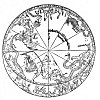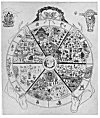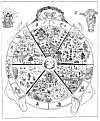
Click to enlarge
PLATE XXVI. CREATIO UNIVERSI
(From Physica Sacra; Johann Jacob Scheuchzer, 1731, Vol. q, Plate I).
CLOSELY ASSOCIATED with the World Mountains are the many Wheels of Life, by which the ancients sought to picture the relations of parts of the universe to each other and to the whole. There is a hint of this in the Tibetan world-picture, with Mount Meru the axis or hub of the world about which are placed like spokes in a wheel the four quarters of the Earth, with their three islands each, making the sum of twelve radii from the centre. The Wheel of the Zodiac was of course the great original for all such figures, particularly for the Wheels of Life. For uncounted centuries man knew the geography of the heavens better than the geography of the Earth, and whatever life on Earth meant to him, the unfailing procession of the great star-groups of the Zodiac meant certainty, law, order. There were zones written in the heavens long before man stretched his imaginary lines of the terrestrial zones over the Earth--"The circle called the Zodiac," said Plutarch, "is placed under the three that are in the midst, and lies obliquely, gently touching them all." And it is not hard to see how this great circle came to seem to man a mirror of the Earth, a storehouse of its history, its constant Watcher in the sky, and the unerring prophet of

Click to enlarge
PLATE XXVI. CREATIO UNIVERSI
(From Physica Sacra; Johann Jacob Scheuchzer, 1731, Vol. q, Plate I).
its future. The Greeks named this oblique ring of star-groups just behind the Sun when it sets or just before it when it rises, the Zodiac or Path of Animals, because the names and configurations of the groups were mostly those of animals, and by that name we know it. But no one knows how long before the days of the Greeks far earlier astronomers first linked the single groups of stars into the twelve great signs of the Star-bearing Circle.
Physica Sacra is an early eighteenth-century Bible illustrated almost text for text, and Plate XXVI is its first illustration, for the first verse of the first chapter of the first book: "In the beginning God created the heaven and the Earth." Outside the Zodiacal Wheel are clouds upon clouds bearing a multitude of spheres, and, in addition, seven numbered diagrams. Fig. I in this Plate illustrates the system of the "eleven heavens," with the Earth the centre of the universe. Fig. II is the Tychonian system; Fig. III, what is known as the semi-Tychonian system; Fig IV, the blazing and effulgent Sun, containing within himself his seven children, Earth and Moon and the five great planets; Fig. V, a group of the heavenly bodies; Fig. VI, an armillary sphere; Fig. VII, an Astrolabe, which is almost to say, "the handle of the stars," and which was called by the old astronomers "the Mathematical jewel."
The Northern and Southern hemispheres of the heavens (Figs. 58 and 59) are merely supplementary to Scheuchzer's Creatio Universi. They are taken from an Arabic celestial globe, made of brass, in 1275 A.D., which was deposited in the Museum of the Royal Asiatic Society of Great Britain and Ireland. Near the South Pole is an inscription
in Cufic characters, stating that it was "Made by the most humble in the supreme God, Mohammed ben Helah, the astronomer of Monsul, in the year of the Hegira

Click to enlarge
FIGURE 58. An ancient Arabic Celestial Sphere. Northern Hemisphere.
(From Transactions of the Royal Asiatic Society of Great Britain and Ireland, 1830, Vol. II, Plate A.)
[paragraph continues] 674." The Zodiac was known to the Arabs, not as The Path of Animals," but as The Girdle of the Castles," and contained, with one or two variations in name, the same signs we have to-day: Aries, Taurus and Gemini, Cancer, Leo, Virgo (this the Arabs called the Ear), Balance or
Libra, Scorpio, Sagittarius, Capricornus, Aquarius, and Pisces.
There are altogether, including the signs of the Zodiac, forty-seven constellations on these Arabic celestial hemi-

Click to enlarge
FIGURE 59. An ancient Arabic Celestial Sphere. Southern Hemisphere.
(From Transactions of the Royal Asiatic Society of Great Britain and Ireland, 1830, Vol. II, Plate B.)
spheres. The ones inscribed on the Northern hemisphere are: Little Bear; Greater Bear; The Dragon; Cepheus; Boötes; the Northern Crown; The Kneeling Hercules; The Lyre; The Hen, or Swan; The Lady in her Chair, or Cassiopeia; The Bearer of Medusa's Head, i.e., Perseus; The
[paragraph continues] Charioteer; The Charmer of Serpents, or Serpentarius; The Arrow, or Sagittarius; The Flying Eagle, or Aquila; The Dolphin; Part of the Horse (the horse's head); The Greater Horse, Pegasus; The Chain, or Andromeda; The Triangle.
The constellations inscribed on the Southern hemisphere are: Ketos, the Whale; The Giant, or Orion; The River, or Acarnar; The Hare, or Lepus; the Greater Dog, or Canis; The Dog, or Procyon; The Ship, or Argo; The Hydra; The Flaggon, or Crater; The Crow, or Corvus; The Centaur, or Centaurus; The Beast, or Fera; The Censer; The Southern Crown; The Southern Fish.
OF THE TWO WHEELS OF LIFE (or Fate or Law) to be given here, we begin with the one that seems the simpler. This Chinese Wheel (Plate XXVII) is almost a Zodiac or "path of animals," of itself. (The Chinese Zodiac, or "Yellow Path of the Sun," differed materially in its signs from the Greek-Arabic one just given; it contained twelve animals: the Mouse, the Cow, the Tiger, the Rabbit, the Dragon, the Serpent, the Horse, the Ram, the Ape, the Hen, the Dog, and the Pig.) Six of the twelve divisions are separating paths or currents, through or over which the traveller passes to the next stage. Four of the remaining divisions are the abodes of beasts, of insects, of fish, and of birds. The other two, separated from each other by one of the spiral-like rivers, are inhabited by Poor Men and Rich Men, or by Mandarins and Tillers of the Soil.

Click to enlarge
PLATE XXVII. THE WHEEL OF LIFE
(From Dragon, Image, and Demon; H. C. Du Bose, 1887)
The second of these wheels is the one elaborately developed in the Tibetan Wheel of Life (Plate XXVIII) to

Click to enlarge
FIGURE 60. Key to the Tibetan Wheel of Life.
(From The Buddhism of Tibet, or Lamaism; L. Austine Waddell, 1899.)
which is an almost necessary Key. It is a Tibetan version of an Indian painting in one of the abandoned cave-temples of Ajanta, which L. Austine Waddell holds to be "a complete authentic account of human life from the absolute standpoint of the earliest Buddhist philosophy."
[paragraph continues] The Lamas of Tibet say that Buddha himself originated the Wheel of Life, forming it on the Earth with grains of rice from a "rice-field school room." According to the old story, while tarrying for a while at the Squirrels' Feeding Ground in the Venuvana forest near Rajagriha, Buddha instructed his disciple Ananda, to make a Wheel, for the sake of illustrating what another disciple had seen when he visited other spheres. This Wheel was to have five spokes, between which were to be shown the several hells, animals, ghosts, gods and men. In the middle a dove, a serpent, and a hog were to symbolise lust, hatred, and ignorance. Around the outer rim was to wind "the twelve-fold circle of causation," in regular and inverse order. Beings were to be shown "as being born in a supernatural way as by the machinery of a water-wheel falling from one state and being produced in another." Buddha himself, as an "Enlightened One," liberated from the fate of recurrence on the Wheel, was to be outside of it--one who had escaped. This diagram, made first of rice-grains, was later filled in (second century A.D.) with pictures by the Indian monk Nagarjuna, but these pictures are said to be not his own inventions, but the visual images of Buddha's own parables and allegories.
The Key to the Tibetan Wheel of Life will be found an aid in following the interpretation of it, which is Waddell's, and is given here much abridged. 1
The disc, symbolising the endless cycle of life, is held
in the grasp of a monster who represents the horrors of Attachment, the wretchedness of Clinging-to-Life.
The broad tire of the Wheel is filled with the twelve-linked closed chain called the Causal Nexus, or "the twelve-fold circle of causation," i.e., the causes of life and of misery. At the centre or nave lie the three vices or delusions, "the Daughters of Desire," symbolising lust, ill-will, and stupidity, which lie at the core of re-birth, and are here given in the forms of a dove, a serpent, and a pig, coloured respectively red, green, and black. The body of the Wheel, filled with varied pictures, is supposed to be constantly revolving, thereby producing "The Whirling on the Wheel" of Life.
The way of escape is indicated by the twelve "links," and the first link is the connecting link between the old life and the new. It might be denominated Unconscious Will to escape. The links in the causal chain are:
I. A blind she-camel (ignorant unconscious will) led by a driver (Karma). In this picture, however, the first link is represented by a blind old woman led by a man, with its meaning the same. II. A potter modelling clay on his wheel (Conformations and impressions of and on formless clay). III. A monkey (the beginning of Consciousness; the new man is approaching to the human, but is still an unreasoning automaton). IV. A man being ferried across an Ocean (Self-consciousness--the Individual crossing the Ocean of Life). V. An empty house (Understanding achieved through "the empty house of the senses"). VI. The Kiss (or contact with the outside world). VII. An arrow entering a man's eye (Feeling or
perception). VIII. A man drinking wine (Desire--or thirst). IX. A man gathering fruit and storing it in baskets (Greed, or the satisfying of Desire). X. A married woman--wife of him whose life is here traced (fuller life, Being, Becoming, even Re-birth and the continuance of Being for another existence). XI. Parent and child (Birth--of an heir). XII. A corpse being carried off to burial (Decay and Death), which leads to I, Unconscious Will for re-birth--and the cycle of the Wheel is begun again.
The ways of "life" or "re-birth" are, from highest to lowest, 1. Gods--the Sura. 2. Titans--the Asura. 3. Man--Nara, or Mi. 4. Beasts--the Du-do or "best goers." 5. Tantalised Ghosts--Pretas. 6. Hell--Naraka or Nal-k’am.
To live in the first three worlds is superior; to live in the last three is inferior--the highest world being Heaven, and the lowest Hell.
In Heaven, above the Titans, on the aethereal summit of Mount Meru, dwell the gods (Plate XXV). In the lowest regions of the heavens dwell the "guardian kings of the four quarters"; Dritarashtra, the white guardian of the East; Virudhaka, the green guardian of the South; Virupaksha, the red guardian of the West; and Vaisravana, the yellow guardian of the North.
In the upper right-hand section of the Wheel of Life the Titans (the Asura or not-gods) have their abode. Since their chief characteristic is pride, this is the world of re-birth for the "proud." The Titans correspond to Satan and his hosts, having been, like Satan, and for like cause,

Click to enlarge
PLATE XXVIII. THE WHEEL OF LIFE
(From The Buddhism of Tibet, or, Lamaism; L. Austine Waddell, 1899)
The following image was scanned directly from the original book, and is higher resolution than the previous.

Click to enlarge
THE WHEEL OF LIFE
(From The Buddhism of Tibet, or, Lamaism; L. Austine Waddell, 1899), p. 108
cast out from Heaven. Living at the foot of Mount Meru, they hover forever between Heaven and Earth. The life of the Titans is much longer than the life of men; but it is the fate of every Titan to die warring against the gods for the fruits of the heavenly Parijata tree, whose branches are in Heaven, but whose roots are in their country--"the tree of the concentrated essence of Earth's products." The Jambu tree is, in reality, according to this reading, the "climber" which encircles the aethereal tree, and through it the quintessence of Jambudvip, or the Jambu continent" of Earth is instilled into the Parijata Tree.
Man--Nara or Mi--lives in the upper left-hand region, constantly confronting the eight miseries--birth, old age, sickness, death, ungratified wishes and struggle for existence, misfortune and punishment for law-breaking, separation from relatives and cherished objects, offensive objects and sensations. Of all these and other phases of ordinary existence pictures abound within the Wheel--birth in a cottage; children at play; village scenes--people drinking wine under a tree; a flute player; women spinning and weaving; a borrower; two traders; a drunken man; workers tilling a field or gathering fuel in a forest or bent under heavy loads; the accidents of life--a man and a horse falling into a river; crime--two men fighting--another on trial--another suffering punishment; government--a king and his ministers; old age, disease--a doctor feeling a sick man's pulse; death--a corpse and funeral ceremonies; religion--a temple placed above all the other objects within the Wheel--that is, Indra's Palace.
Beasts--lower right-hand quarter--are more miserable
than man. They are shown consuming each other and being consumed; hunted by men, overburdened with loads, and filled with fear. Far beneath the waters of this animal world is the region of the Nagas or Mermen (great snakes), their home preyed upon by Garuda, Lord of birds, seeking here the serpents of the deep for food.
The region of the Tantalised Ghosts--lower left-hand quarter, is situated above Hell, and hunger and thirst torture the inhabitants. Always before their eyes there are food and drink and jewels in abundance, but the Pretas have mouths no larger than the size of a needle's eye, throats no wider than a hair's diameter, and through these openings they can never satisfy their huge bodily appetites. Add to this that, when food is taken, it is changed into knives or molten metal, and their hunger and thirst can be realised as incessant and never to be appeased. The little pictures within the Wheel show flames pouring from their mouths--if they touch water, it changes to liquid fire. The great Maudgalyayana once descended to the Tibetan purgatory to relieve his mother's distress, but even he could not aid her, and the rice he offered her turned to fiery ashes as she touched it.
Hell, the lowest region, is "situated in the bowels of the human Earth," and is ruled over by Yama, king and judge of the dead, who must himself every day swallow molten metal. His domain is divided into many compartments, each with its special form of punishment for the expiation of different sins. In the upper part of Hell sits Yama with his good and evil angels, ghosts of the dead, the Weigher, and the Prisoner. Below are the Hot Hells, and the Cold
[paragraph continues] Hells, to each of which the damned are assigned according to their sins. The Hot Hells are sunk in the Earth, beginning at a depth of 11,900 miles, and they reach to a depth of 40,000 miles. They are of deepest black, although each is surrounded by a wall of fire. The Cold Hells are at the very edge of the Universe, circled by icy mountains and supplied with glacier water in which the victims are constantly immersed, until chilblains appear and become great sores and ulcers.
There is an exit from Hell, through a sort of borderland Hell called "the near (to re-birth) cycle." This has four divisions; the first filled with hot ashes and dead bodies and offal; the second a quagmire or "sinking sands," beyond which is a forest of spears, which must be crossed--like the razor-bridge of Mohammed, the Bi-frost of Yggdrasil, the slippery fir-tree of the American Indians, or the wide river of The Pilgrim's Progress. After--if--the bridge is crossed, there comes a river of freezing water whose farther shore is thickly set with tree stumps bearing three spiked leaves which impale the pilgrim. What is left to man after this pilgrimage is called "The Surviving Thing."
140:1 Buddhism, or The Lamas of Tibet; L. Austine Waddell, pp. 105-121.